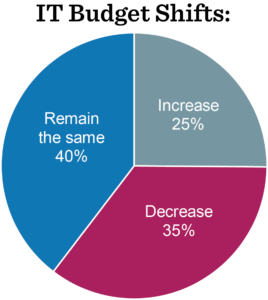Through CIO’s IT leadership focused research – State of the CIO and CIO Tech Poll: Tech Priorities – we have seen consistent IT budget growth, focus on strategic initiatives, and growing activity around emerging technologies year over year. In the beginning of 2020, 59% of IT leaders expected their IT budgets to increase over the next 12 months while only 7% expected a decrease in budget. Organizations were actively researching innovative solutions such as 5G, AI & machine learning, and IoT. COVID-19 has brought sudden and unforeseen shifts to these plans.
In order to get a better understanding of how organizations were prepared and continue to plan for these changes, as well as how IT leaders are responding, CIO conducted a COVID-19 Impact Study. According to the results, only 49% of IT decision-makers (ITDMs) agree that their crisis/pandemic/ resiliency planning process prepared them for the current situation – which increases to 61% for healthcare businesses but decreases to 36% for government. Check out additional highlights below.
Thoughts on Social and Work Restrictions
With social distancing restrictions beginning on March 13th for the majority of the United States, ITDMs anticipate the total average duration to be 10.2 weeks. Also, 59% expect these restrictions to last for more than 10 weeks – increasing to 66% for those in the New York and New Jersey area, and decreasing to 49% for those in Texas. With this, we’re looking at early May for some form of “normalcy.”

Despite this level of uncertainty, there are some notes of encouragement. 68% agree that their technology infrastructure was prepared to adequately address employees working from home – only 49% of government respondents agree compared to 81% in the financial services industry. Close to ¾ (71%) say that the current situation has created a more positive view of remote workplace policies and will likely impact how they plan for office space, tech staffing and overall staffing in the future.

Impact on Tech and Business Initiatives
In order to address this new work dynamic, 44% will need to acquire new technology solutions/services. Given the fact that government ITDMs did not have confidence in their infrastructure as it relates to WFH, it’s no surprise that this number increases to 55% for those in the government sector. More areas of uncertainty arise when thinking about how IT budgets will change in the next 12 months. It’s encouraging to see that 40% expect their IT budgets to remain the same and 25% expect their budgets to increase, while 35% expect a decrease. Also, half of ITDMs anticipate that their supply chain
will see continued disruptions, impacting their ability to innovate.
No doubt, the pandemic has affected how businesses are prioritizing what they are focused on. IT leaders report that their organizations are prioritizing increasing operations efficiency, transforming existing business processes, optimizing employee digital experience, improving customer experience, and increasing cybersecurity protections.
Shifting Focus from Strategic and Innovative to Responsive and Preventative
Prior to COVID-19, CIO conducted the 2020 State of the CIO research which outlined the activities that CIOs spend the majority of their time focusing on, and what they’d like to focus on in the next 3 years. Six months ago, IT leaders were spending time on security management, aligning IT initiatives with business goals, improving IT operations/systems performance, implementing new systems & architecture, and driving business innovation. Their expectations for the next three years were to focus on driving business innovation, identifying opportunities for competitive differentiation, developing and refining business strategy, aligning IT initiatives with business goals, and developing new go-to-market strategies and technologies. These have shifted significantly as IT leaders now anticipate spending time on cost control/expense management, improving IT operations/systems performance, redesigning business processes, developing and refining business strategy, and security management.

There is some good news, however. When asked what their CEO’s top three priorities for IT are to help the business through the current disruption, the priorities are fairly aligned with what the business asked of IT prior to COVID-19. In fact, the #1 priority remains the same – lead digital business/digital transformation initiatives. Other top priorities, prior to the pandemic, were upgrade IT and data security to boost corporate resiliency and strengthen IT and business collaboration skills; while now priorities have shifted to improve remote work experiences, and upgrade IT and data security to boost corporate resiliency.
Conclusions
- IT leaders will continue to asses their crisis/pandemic/resiliency planning process to strengthen their preparation for the future.
- COVID-19 will create lasting changes to how we work, as organizations develop a more positive view of a work from home structure.
- Expense management becomes a key task on IT leaders’ radar as they shift their focus from strategic and innovative to responsive and preventative.
- More efficient processes are being prioritized, such as increased operational efficiency and transforming existing business processes.
- Initiatives to create a more digital business continue to be top of mind for IT leaders and businesses overall.





